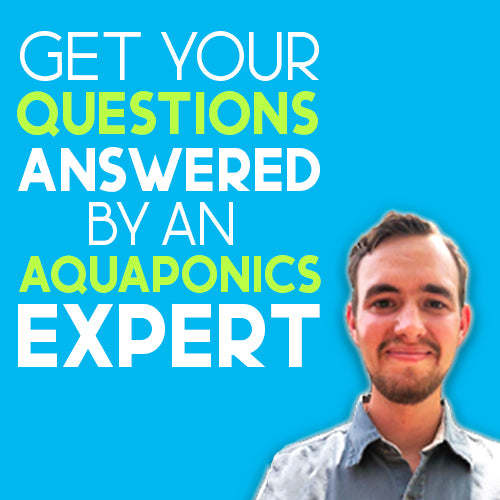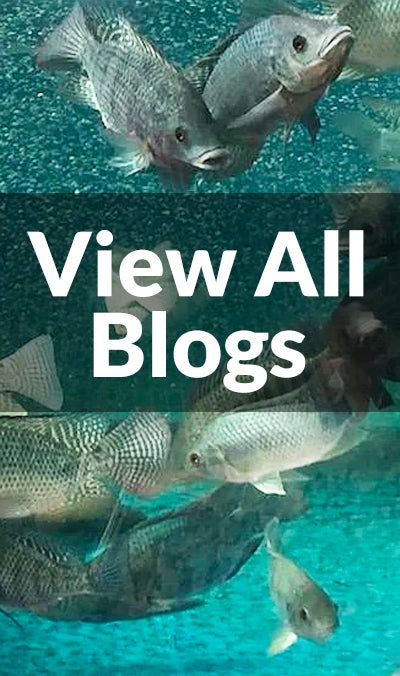The significant difference between an aquaponics system to other soilless gardening methods is that it relies on the fish as the main nutrients provider to the plants. Thus, the fish and fish feed must provide the nutritional requirements needed by the plants to grow in an aquaponics system. This is why many aquaponics growers are experimenting with various strategies to optimize fish performance.
Fish diets can be manipulated to provide sufficient nutrients, and feeding schedules are designed to provide nutrients at the right level and time to complement fish, plants, and bacteria.This article looks at aquaponics fish feed and fish feeding and the best practices to serve as your guide to optimize fish and plant growth in your aquaponics system.
The Basic Components and Nutrition of Aquaponics Fish Food
In aquaponics, proper fish nutrition and care is essential because the fish feed has to fulfill both the fish and plants' nutritional needs. Your fish will have slower growth, reduced breeding success, and low disease resistance without adequate nutrition.
Fish require a balanced diet and should regularly be fed healthy foods that meet their nutritional needs. Fish food must contain enough protein, carbohydrates, fat, fiber, phosphorus, and other vitamins and minerals for the fish to produce enough wastes for the plants and keep the overall health of the tank at a high level.
- Protein: Protein is an essential component of building fish mass. Younger fish require a rich protein diet to grow at an optimal level during their grow-out stage.
- Fish Oil: Fish oil is a common component of fish feeds. Fish oil is high in two types of fats, omega-3, and omega-6, which are also beneficial for humans.
- Carbohydrates: Carbohydrates are the most important and cheapest energy source for animals. Carbohydrates consist mainly of starch and sugar, which help bind the feed together to make a pellet.
- Lipids: Lipids provide energy and essential fatty acids necessary for the fish's growth and other biological functions. Fats also play a crucial role in absorbing fat-soluble vitamins and securing the production of hormones. Fatty acid deficiency in fish can cause reduced growth and limited reproductive efficiency.
- Vitamins and minerals: These are necessary for fish health and growth. Vitamins are the organic molecules synthesized by plants that are important for the development and immune system functions. Minerals are required for the fish to synthesize their body components and cellular structures.

Aquaponics Fish Food
There are many kinds of foods available for your aquaponics fish. You can use alternative fish food such as duckweeds and leftover vegetables or feed your fish with commercial fish feed. The feed you provide will depend on the species, size, and age of the fish you are raising. Here are the common fish feeds used in aquaponics systems.
1. Pellets or Flakes:Most commercial fish feeds are in the form of pellets or flakes. Pellets are fish feed that sinks in the water while flakes float. The advantage of using fish pellets is that the fish can swallow them naturally as they sink into the water. The disadvantage of pellets is they need to be taken out of the water after feeding to avoid water quality issues. The advantage of using fish flakes is that they do not quickly get spoiled and stay on top of the water. Your fish behavior will determine the selection between pellets and flakes.
2. Aquatic Plants: You can grow duckweed, algae, water lettuce, azolla, and other aquatic plants to feed your aquaponics fish. These plants are easy to grow. However, they need to be taken care of properly as they can clog your pump and pipes.
3. Worm and Insects:You can also grow worms and insects like dragonflies, wingless flies, and earthworms to feed your fish.
Types of Aquaponics Fish and Aquaponics Fish Feed
- Tilapia: Tilapia is an omnivorous warm-water fish. They feed on pellet fish food, duckweed, and veggies. You can feed them with veggies from your system, such as lettuce and other leafy greens.
- Yellow perch: This fish species prefers cool water and is adjustable to the changes of pH level of water. Yellow perch feed on pellets and veggies.
- Trout: Troutis one of the more challenging fish to raise in an aquaponics system because they require a higher level of dissolved oxygen. These fish species are predatory and feed on small fish. However, they can also survive on pellet fish food. Trout prefer being in a cool water temperature.
- Catfish, Bass and Bluegill: These fish species are usually raised in ponds. They are sensitive to temperature, pH levels, and other water quality parameters. These are bottom feeders and feed on pellet fish food.
- Goldfish and Koi: Goldfish and koi are ornamental fish, meaning they are not raised for food. These fish species are hardy fish. They feed on flakes and pellets, bugs, and veggies.
Factors to Consider in Feeding Aquaponics Fish
Feeding your aquaponics fish entails a proper understanding of several factors, such as your tank's water temperature, pH levels, fish species and size, and fish biomass.
- Water Temperature: always check the water temperature of your fish tank to ensure it is optimal for the fish you are raising. Fish are poikilothermic, meaning they cannot regulate their body temperature. So when the water is too cold or too hot for the fish in the tank, it will decrease their appetite and cause fish stress.
- pH Level: The pH level can also cause fish stress, so ensure that the pH level is always in the ideal range for the fish, plants, and bacteria.
- Fish Species and Size:It is crucial to consider the type and size of fish you raise when feeding your aquaponics fish. Bigger fish require larger pellets, while smaller fish require tinier feeds.
- Biomass:The biomass of your fish is crucial in feeding your aquaponics fish because you need to adjust your fish feed according to the biomass of your fish. Biomass is the total weight of your fish, which means if you have 20 fish in your fish, with an average of 200 grams each. The biomass of your fish is 4,000 grams.

Determining How Much to Feed Your Aquaponics Fish
Most aquaponics growers follow the simple rule of feeding their fish what they can consume in just five minutes and removing any uneaten fish after five minutes to avoid unwanted water quality issues. If you have a new system and are still cycling with the fish process, feeding should be kept in small amounts until the system is fully cycled.
If your fish don't seem to be hungry, don't feed them. Fish can survive for many days without feeding. Also, keep in mind that fish will generally consume 1% to 2% of their body weight every day.
You can feed your fish two or three times a day. You can feed your fish manually, or you use an automatic fish feeder if you are not in your garden 24/7. You can schedule your feeding time in the morning, afternoon, and before dusk. If you plan on a twice-a-day feeding, you can schedule it in the morning and afternoon. Make it a part of your feeding habit to observe your fish while feeding to see if there are changes in their behavior. If you notice something is not normal, immediately give the proper attention to avoid more issues.
Feeding Tips for Fish in Aquaponics
- Your fish food should be adapted to the size and mouth of your fish. Fingerlings have smaller mouths, so feed them with small pellets or flakes. Big fish will eat bigger fish food.
- Feeding should be done twice or thrice a day.
- Ensure not to overfeed your fish by feeding them what they can consume for five minutes.
- After feeding, wait for another five minutes and remove any leftover fish food immediately, as this can affect the water quality.
- Fish usually eat 1-2% of their body weight per day.
- Do not feed your fish when they are stressed or sick.
- Regularly check the quality of the water.
- Observe your fish behavior while feeding to see if there are changes in the fish behavior.
- Keep in mind the fish to plant ratio to ensure your plants receive the right amount of nutrients.
Conclusion
Fish feed and proper fish feeding are essential for growing a successful aquaponics system. Keep in mind that the food for your fish will become the fertilizer for your plants, so make sure to use quality fish food. A successful and profitable aquaponics system begins with quality fish food appropriate to the fish you are raising.






SB Group Nepal
May 04, 2024
I really appreciate this wonderful post that you have provided for us. I feel strongly that I love and read more on this topic. I have spent a lot of my spare time reading your content. Thank you a lot.